Case Study: Factors Influencing Nurse Job Satisfaction in Guangdong
VerifiedAdded on 2023/06/11
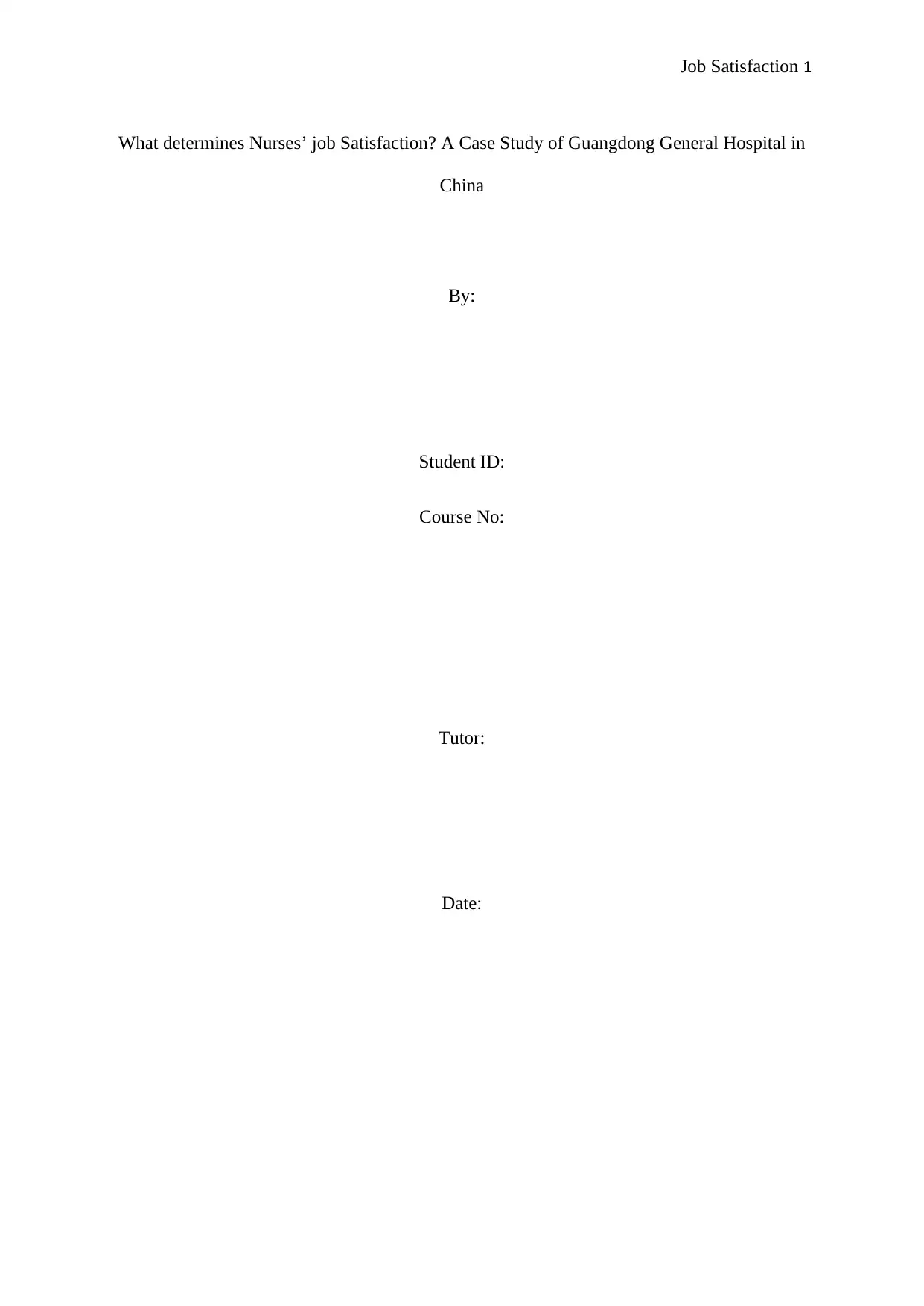
What determines Nurses’ job Satisfaction? A Case Study of Guangdong General Hospital in
China
By:
Student ID:
Course No:
Tutor:
Date:
Paraphrase This Document

Table of Contents
List of Figures............................................................................................................................3
List of Tables..............................................................................................................................4
Research Proposal......................................................................................................................5
1.0 Research Title and Introduction.......................................................................................5
1.1 Research Questions..........................................................................................................5
1.2 Research Objectives and Framework...............................................................................6
1.3 Research Methodology and Design..................................................................................7
1.3.1 Research Philosophy..................................................................................................7
1.4 Description of Method......................................................................................................7
1.4.1 Research Design........................................................................................................7
1.4.2 Target Population.......................................................................................................7
1.4.3 Sample Size and Sampling Techniques.....................................................................8
1.5 Data Collection and Analysis...........................................................................................9
1.6 Validity and Reliability..................................................................................................11
1.7 Project Timeline: Gantt Chart........................................................................................12
1.8 Ethical Considerations....................................................................................................12
References................................................................................................................................14
Appendices...............................................................................................................................17
Appendix 1: Questionnaire...................................................................................................17
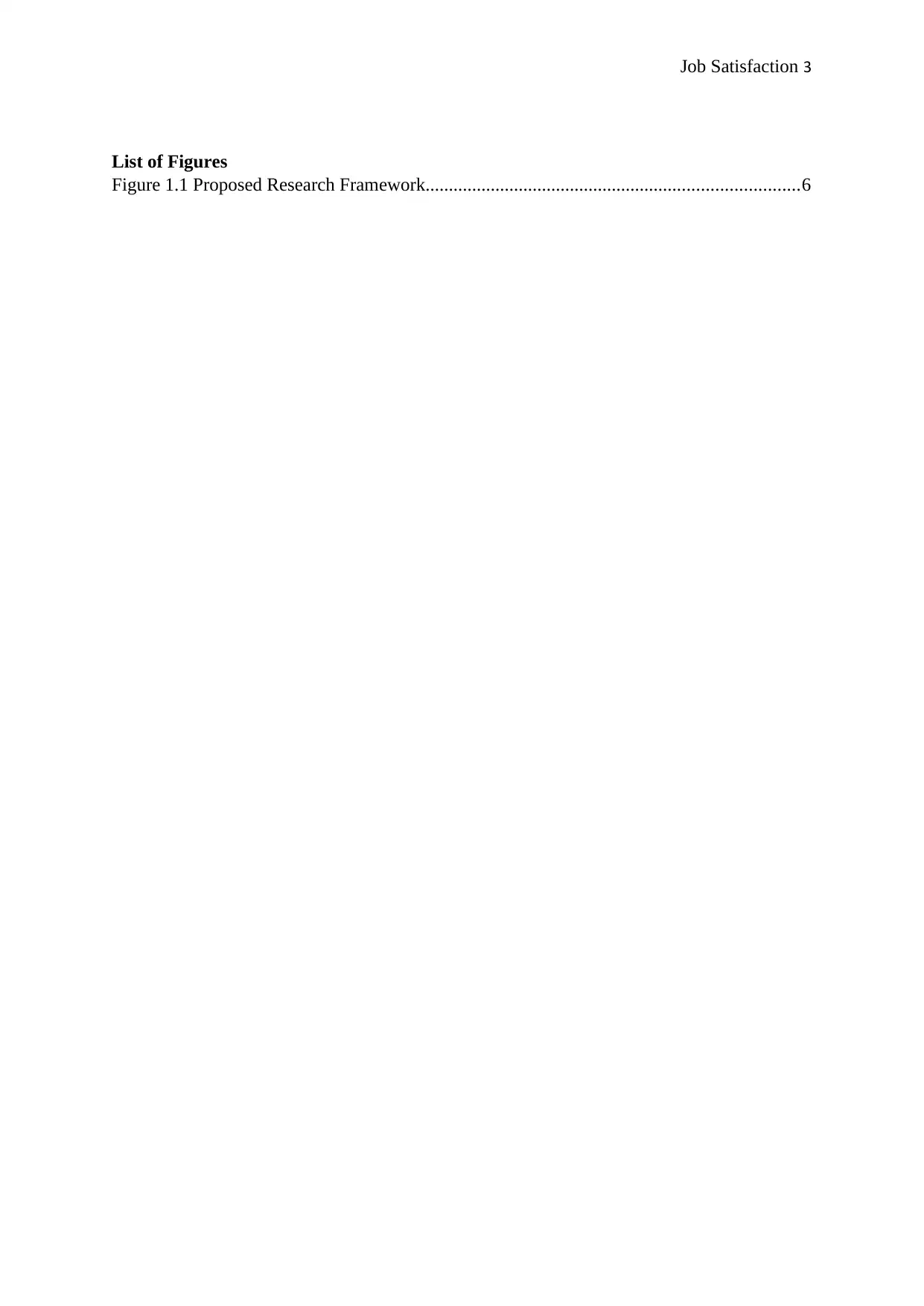
List of Figures
Figure 1.1 Proposed Research Framework................................................................................6
⊘ This is a preview!⊘
Do you want full access?
Subscribe today to unlock all pages.

Trusted by 1+ million students worldwide
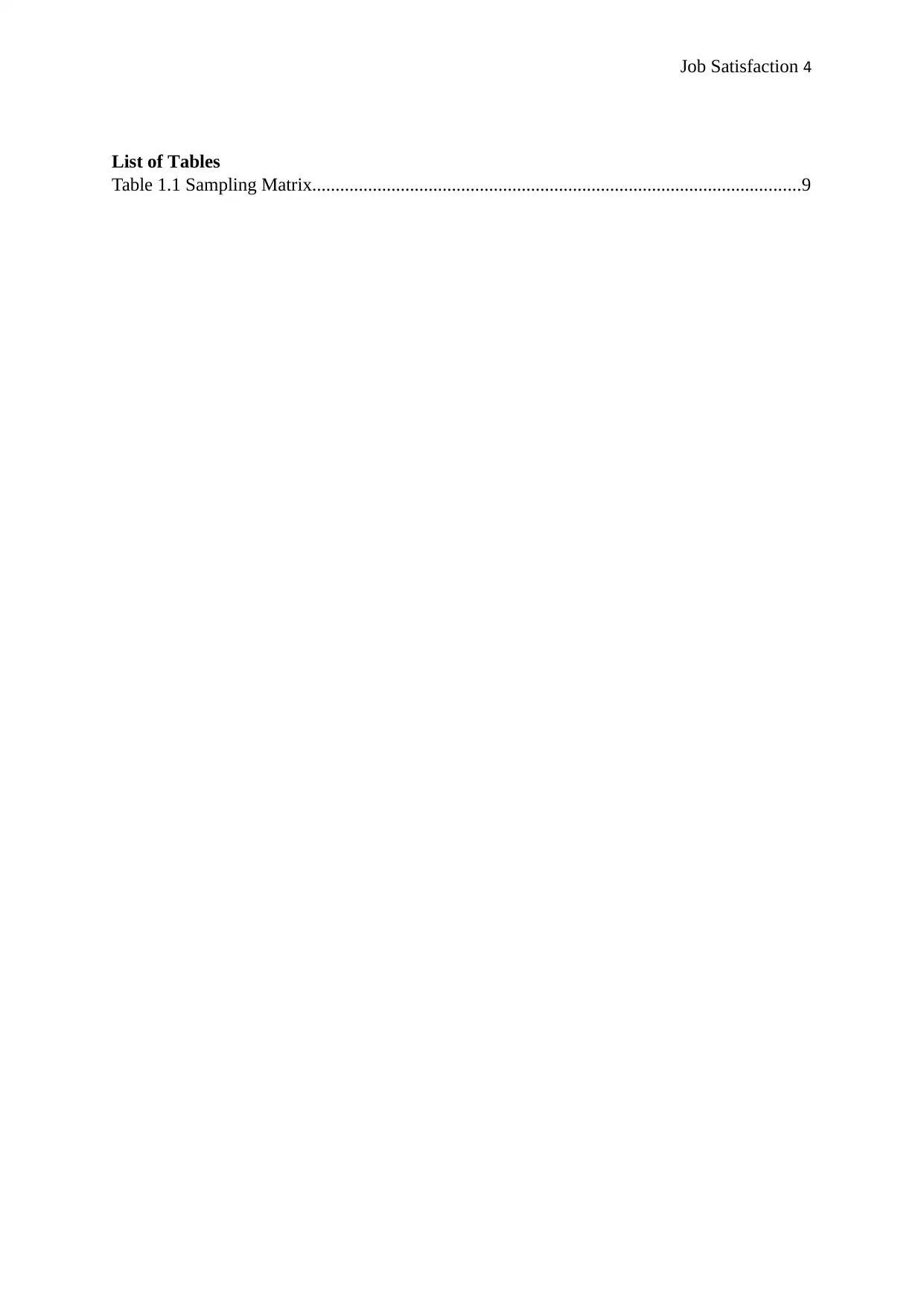
List of Tables
Table 1.1 Sampling Matrix.........................................................................................................9
Paraphrase This Document
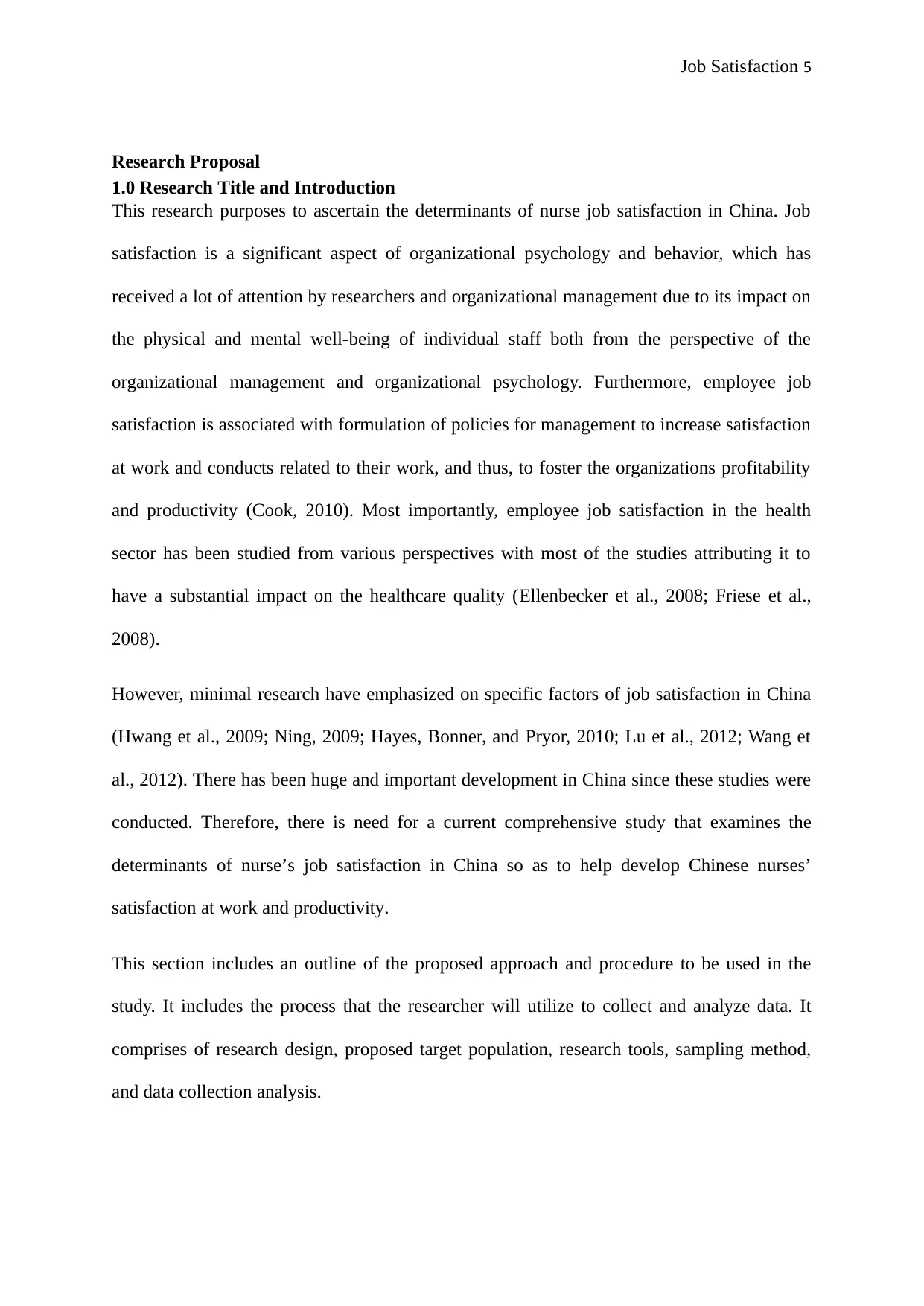
Research Proposal
1.0 Research Title and Introduction
This research purposes to ascertain the determinants of nurse job satisfaction in China. Job
satisfaction is a significant aspect of organizational psychology and behavior, which has
received a lot of attention by researchers and organizational management due to its impact on
the physical and mental well-being of individual staff both from the perspective of the
organizational management and organizational psychology. Furthermore, employee job
satisfaction is associated with formulation of policies for management to increase satisfaction
at work and conducts related to their work, and thus, to foster the organizations profitability
and productivity (Cook, 2010). Most importantly, employee job satisfaction in the health
sector has been studied from various perspectives with most of the studies attributing it to
have a substantial impact on the healthcare quality (Ellenbecker et al., 2008; Friese et al.,
2008).
However, minimal research have emphasized on specific factors of job satisfaction in China
(Hwang et al., 2009; Ning, 2009; Hayes, Bonner, and Pryor, 2010; Lu et al., 2012; Wang et
al., 2012). There has been huge and important development in China since these studies were
conducted. Therefore, there is need for a current comprehensive study that examines the
determinants of nurse’s job satisfaction in China so as to help develop Chinese nurses’
satisfaction at work and productivity.
This section includes an outline of the proposed approach and procedure to be used in the
study. It includes the process that the researcher will utilize to collect and analyze data. It
comprises of research design, proposed target population, research tools, sampling method,
and data collection analysis.
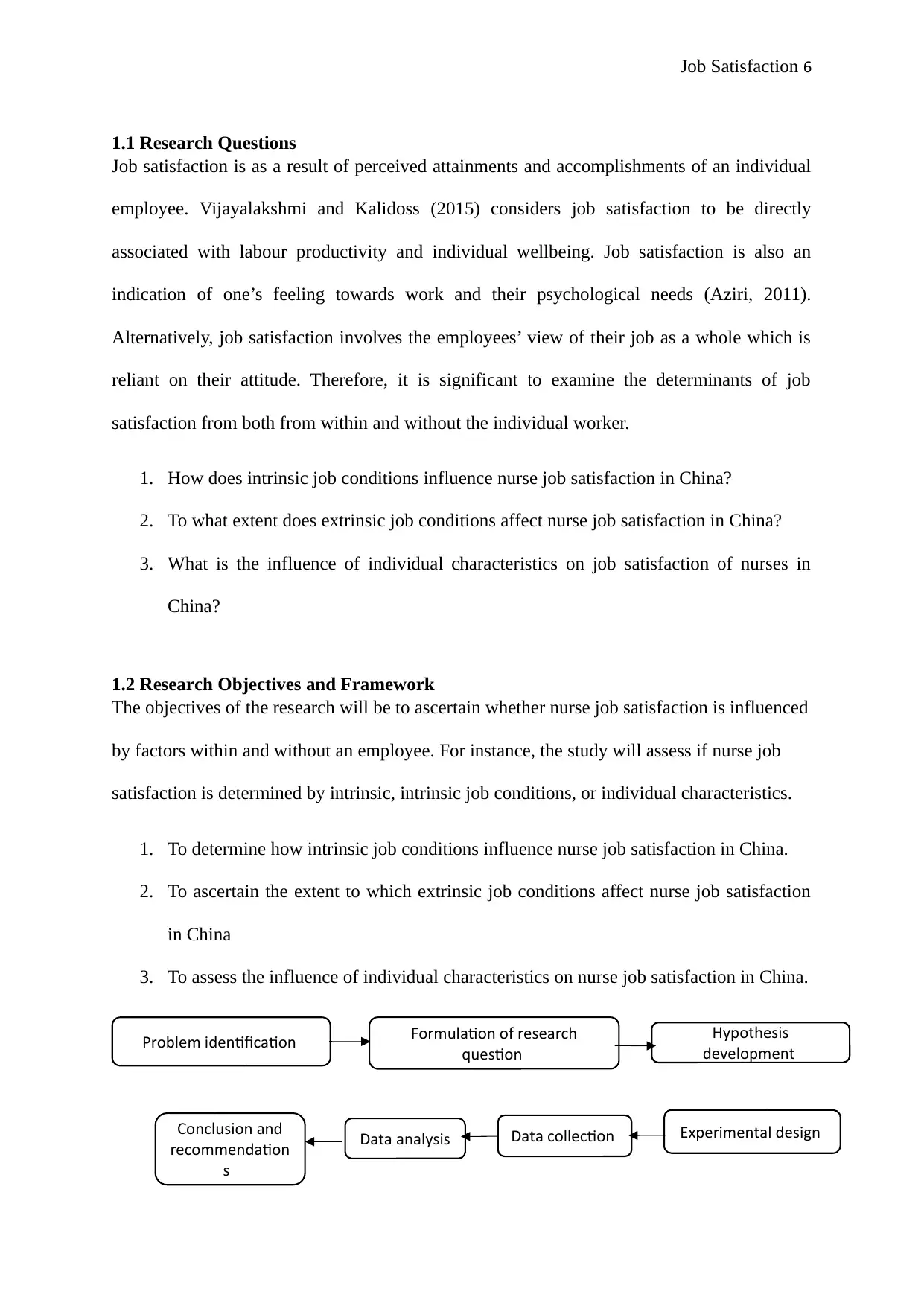
1.1 Research Questions
Job satisfaction is as a result of perceived attainments and accomplishments of an individual
employee. Vijayalakshmi and Kalidoss (2015) considers job satisfaction to be directly
associated with labour productivity and individual wellbeing. Job satisfaction is also an
indication of one’s feeling towards work and their psychological needs (Aziri, 2011).
Alternatively, job satisfaction involves the employees’ view of their job as a whole which is
reliant on their attitude. Therefore, it is significant to examine the determinants of job
satisfaction from both from within and without the individual worker.
1. How does intrinsic job conditions influence nurse job satisfaction in China?
2. To what extent does extrinsic job conditions affect nurse job satisfaction in China?
3. What is the influence of individual characteristics on job satisfaction of nurses in
China?
1.2 Research Objectives and Framework
The objectives of the research will be to ascertain whether nurse job satisfaction is influenced
by factors within and without an employee. For instance, the study will assess if nurse job
satisfaction is determined by intrinsic, intrinsic job conditions, or individual characteristics.
1. To determine how intrinsic job conditions influence nurse job satisfaction in China.
2. To ascertain the extent to which extrinsic job conditions affect nurse job satisfaction
in China
3. To assess the influence of individual characteristics on nurse job satisfaction in China.
Problem identification Formulation of research
question
Hypothesis
development
Experimental designConclusion and
recommendation
s
Data collectionData analysis
⊘ This is a preview!⊘
Do you want full access?
Subscribe today to unlock all pages.

Trusted by 1+ million students worldwide

Figure 1.1 Proposed Research Framework
Figure 1 Figure 1.1 Proposed Research Framework
1.3 Research Methodology and Design
1.3.1 Research Philosophy
This research will adopt interpretivism philosophical approach for research. Interpretivism
contends that society is too intricate to generalize, and there exists no objective reality, but a
subjective reality in which it’s significant to comprehend the inspirations, intentions, and
actions of people (Bunniss and Kelly, 2010). Nurse Job satisfaction is a complex social aspect
because there exists varying definitions of job satisfaction. Furthermore, nurse job
satisfaction is determined by various aspects that range from individual characteristics to the
nature of the workplace. This therefore makes it difficult to objectively generalize the
determinants of nurse job satisfaction but instead to subjectively approach the study. Hence,
the justification of the use of interpretivism for this research.
1.4 Description of Method
1.4.1 Research Design
The survey will adopt a descriptive survey research design. Creswell and Creswell (2017)
observes that descriptive survey design is most appropriate in exploratory studies because it
permits the researcher to collect data, summarize, present and deduce for the aim of
clarification. McMillan and Schumacher (2010) also argues that descriptive survey design
best fits in the study of behavioral sciences because it aims at ascertaining factors related with
the manifestation of specific events and contexts of behaviors. The adoption of this design
will also ensure that the researcher doesn’t influence any of the control variables but only
provides a description of the scenario in its actuality and provides the association between
them. Therefore, this design will enable the investigator to ascertain the determinants of nurse
job satisfaction in China.
Paraphrase This Document
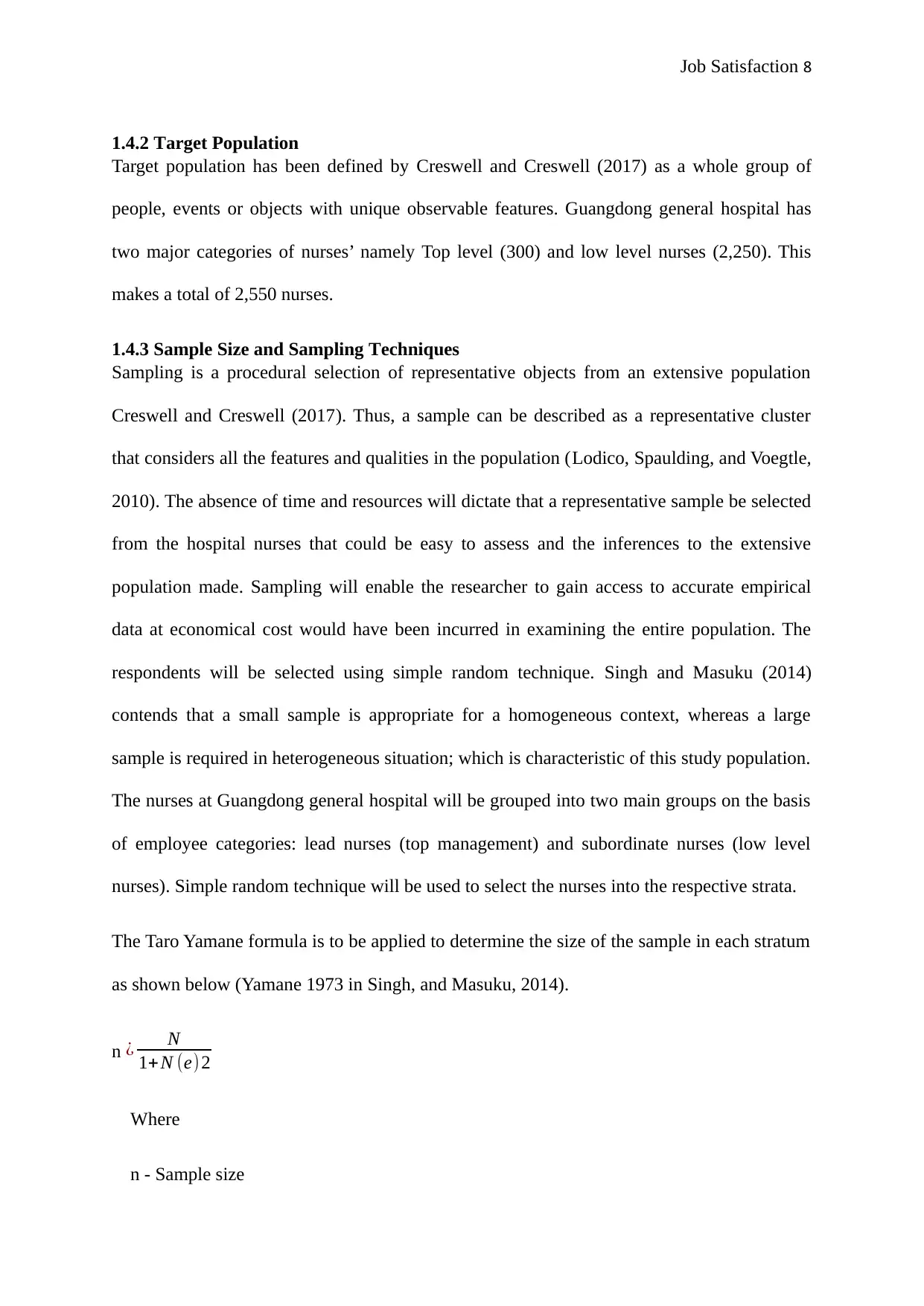
1.4.2 Target Population
Target population has been defined by Creswell and Creswell (2017) as a whole group of
people, events or objects with unique observable features. Guangdong general hospital has
two major categories of nurses’ namely Top level (300) and low level nurses (2,250). This
makes a total of 2,550 nurses.
1.4.3 Sample Size and Sampling Techniques
Sampling is a procedural selection of representative objects from an extensive population
Creswell and Creswell (2017). Thus, a sample can be described as a representative cluster
that considers all the features and qualities in the population (Lodico, Spaulding, and Voegtle,
2010). The absence of time and resources will dictate that a representative sample be selected
from the hospital nurses that could be easy to assess and the inferences to the extensive
population made. Sampling will enable the researcher to gain access to accurate empirical
data at economical cost would have been incurred in examining the entire population. The
respondents will be selected using simple random technique. Singh and Masuku (2014)
contends that a small sample is appropriate for a homogeneous context, whereas a large
sample is required in heterogeneous situation; which is characteristic of this study population.
The nurses at Guangdong general hospital will be grouped into two main groups on the basis
of employee categories: lead nurses (top management) and subordinate nurses (low level
nurses). Simple random technique will be used to select the nurses into the respective strata.
The Taro Yamane formula is to be applied to determine the size of the sample in each stratum
as shown below (Yamane 1973 in Singh, and Masuku, 2014).
n ¿ N
1+N (e) 2
Where
n - Sample size
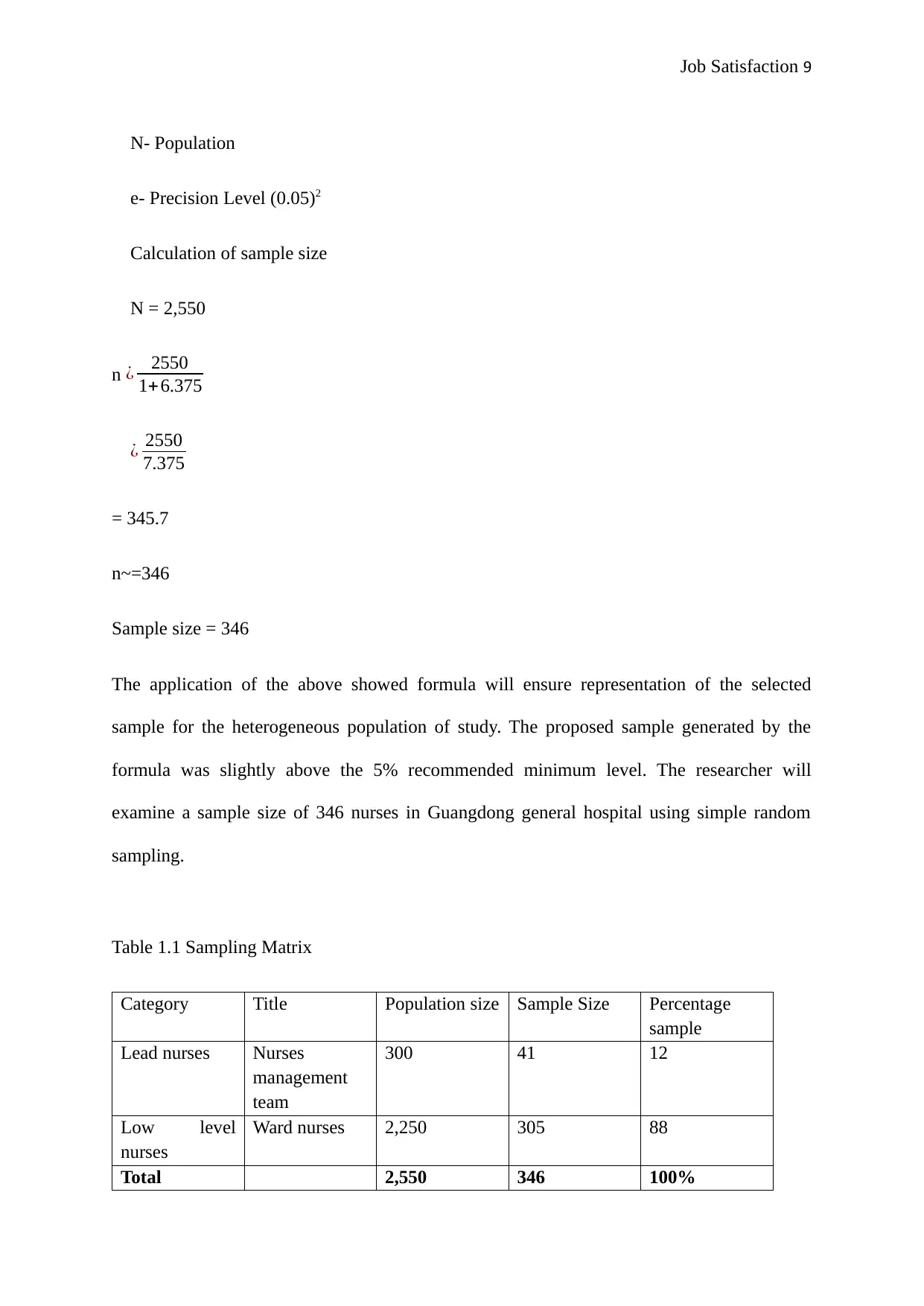
N- Population
e- Precision Level (0.05)2
Calculation of sample size
N = 2,550
n ¿ 2550
1+6.375
¿ 2550
7.375
= 345.7
n~=346
Sample size = 346
The application of the above showed formula will ensure representation of the selected
sample for the heterogeneous population of study. The proposed sample generated by the
formula was slightly above the 5% recommended minimum level. The researcher will
examine a sample size of 346 nurses in Guangdong general hospital using simple random
sampling.
Table 1Table 1.1 Sampling Matrix
Table 1.1 Sampling Matrix
Category Title Population size Sample Size Percentage
sample
Lead nurses Nurses
management
team
300 41 12
Low level
nurses
Ward nurses 2,250 305 88
Total 2,550 346 100%
⊘ This is a preview!⊘
Do you want full access?
Subscribe today to unlock all pages.

Trusted by 1+ million students worldwide
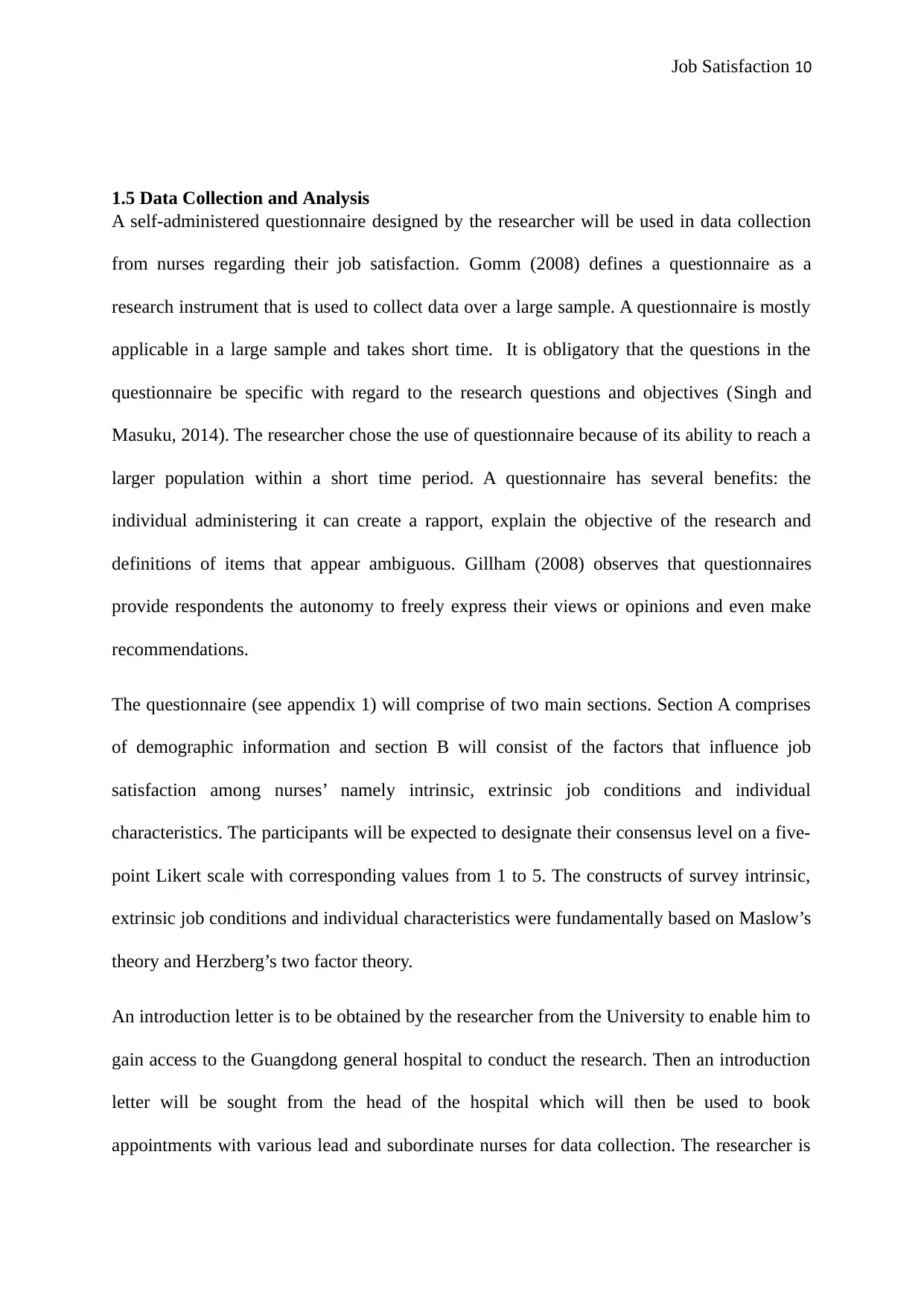
1.5 Data Collection and Analysis
A self-administered questionnaire designed by the researcher will be used in data collection
from nurses regarding their job satisfaction. Gomm (2008) defines a questionnaire as a
research instrument that is used to collect data over a large sample. A questionnaire is mostly
applicable in a large sample and takes short time. It is obligatory that the questions in the
questionnaire be specific with regard to the research questions and objectives (Singh and
Masuku, 2014). The researcher chose the use of questionnaire because of its ability to reach a
larger population within a short time period. A questionnaire has several benefits: the
individual administering it can create a rapport, explain the objective of the research and
definitions of items that appear ambiguous. Gillham (2008) observes that questionnaires
provide respondents the autonomy to freely express their views or opinions and even make
recommendations.
The questionnaire (see appendix 1) will comprise of two main sections. Section A comprises
of demographic information and section B will consist of the factors that influence job
satisfaction among nurses’ namely intrinsic, extrinsic job conditions and individual
characteristics. The participants will be expected to designate their consensus level on a five-
point Likert scale with corresponding values from 1 to 5. The constructs of survey intrinsic,
extrinsic job conditions and individual characteristics were fundamentally based on Maslow’s
theory and Herzberg’s two factor theory.
An introduction letter is to be obtained by the researcher from the University to enable him to
gain access to the Guangdong general hospital to conduct the research. Then an introduction
letter will be sought from the head of the hospital which will then be used to book
appointments with various lead and subordinate nurses for data collection. The researcher is
Paraphrase This Document
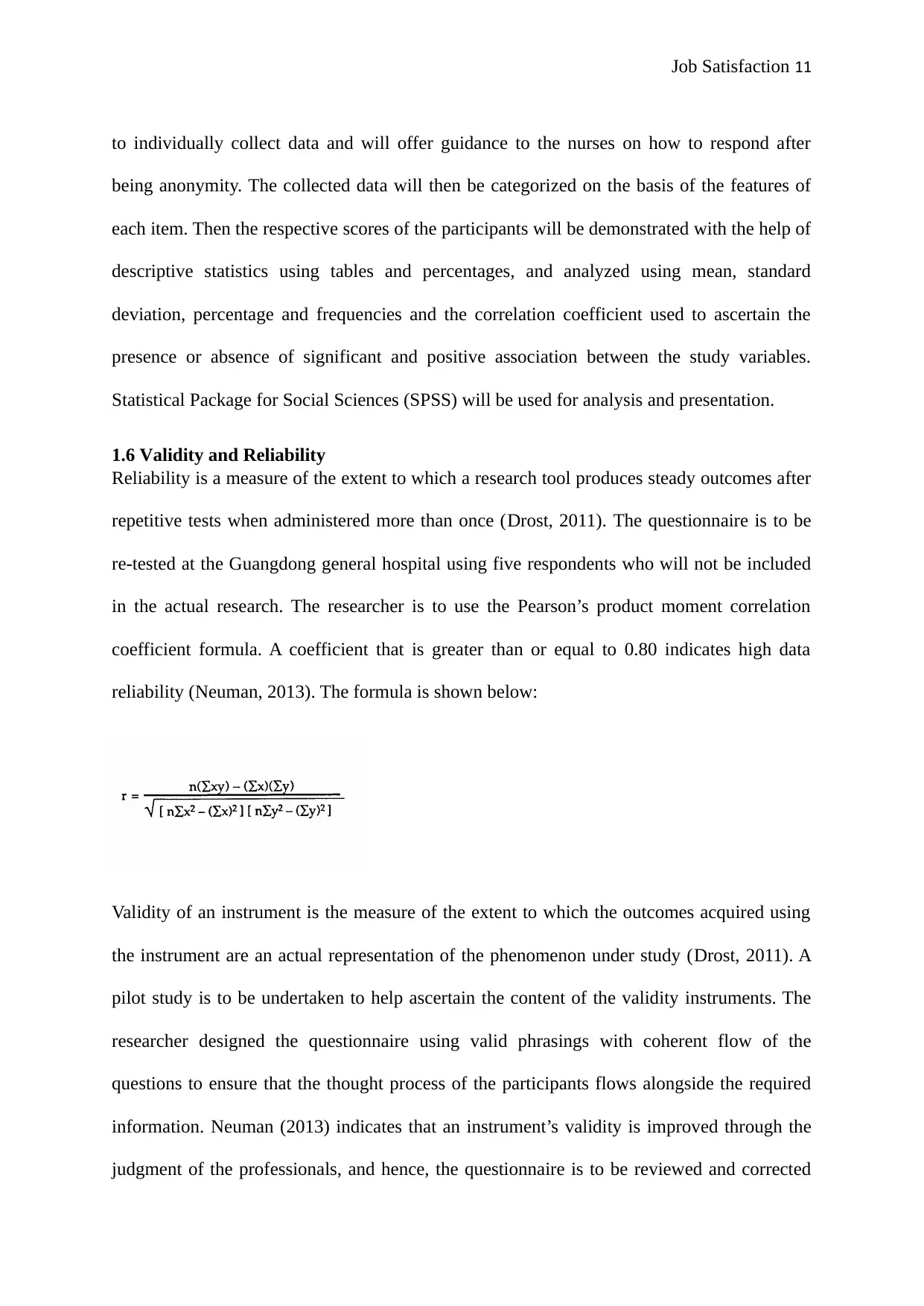
to individually collect data and will offer guidance to the nurses on how to respond after
being anonymity. The collected data will then be categorized on the basis of the features of
each item. Then the respective scores of the participants will be demonstrated with the help of
descriptive statistics using tables and percentages, and analyzed using mean, standard
deviation, percentage and frequencies and the correlation coefficient used to ascertain the
presence or absence of significant and positive association between the study variables.
Statistical Package for Social Sciences (SPSS) will be used for analysis and presentation.
1.6 Validity and Reliability
Reliability is a measure of the extent to which a research tool produces steady outcomes after
repetitive tests when administered more than once (Drost, 2011). The questionnaire is to be
re-tested at the Guangdong general hospital using five respondents who will not be included
in the actual research. The researcher is to use the Pearson’s product moment correlation
coefficient formula. A coefficient that is greater than or equal to 0.80 indicates high data
reliability (Neuman, 2013). The formula is shown below:
Validity of an instrument is the measure of the extent to which the outcomes acquired using
the instrument are an actual representation of the phenomenon under study (Drost, 2011). A
pilot study is to be undertaken to help ascertain the content of the validity instruments. The
researcher designed the questionnaire using valid phrasings with coherent flow of the
questions to ensure that the thought process of the participants flows alongside the required
information. Neuman (2013) indicates that an instrument’s validity is improved through the
judgment of the professionals, and hence, the questionnaire is to be reviewed and corrected
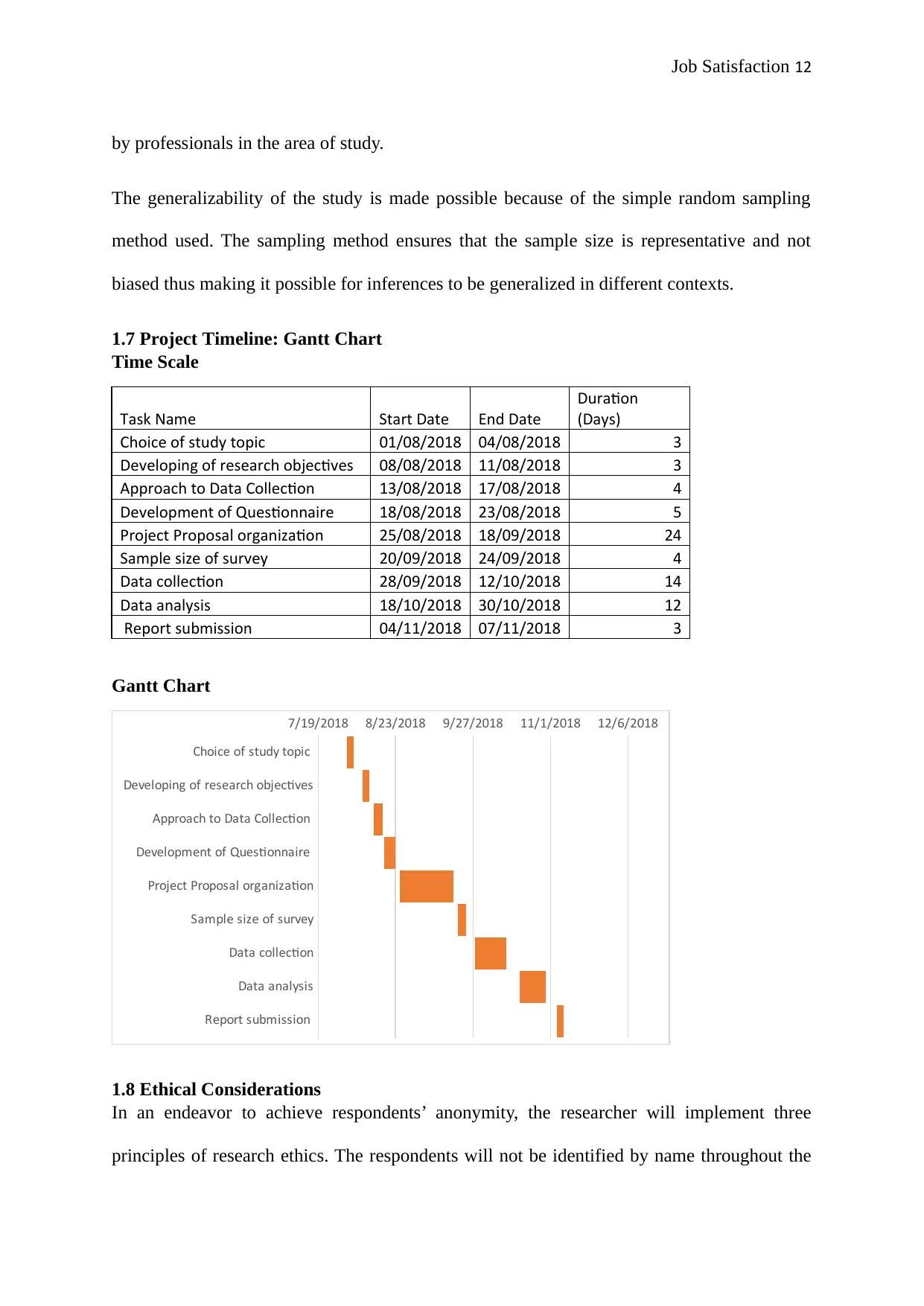
by professionals in the area of study.
The generalizability of the study is made possible because of the simple random sampling
method used. The sampling method ensures that the sample size is representative and not
biased thus making it possible for inferences to be generalized in different contexts.
1.7 Project Timeline: Gantt Chart
Time Scale
Task Name Start Date End Date
Duration
(Days)
Choice of study topic 01/08/2018 04/08/2018 3
Developing of research objectives 08/08/2018 11/08/2018 3
Approach to Data Collection 13/08/2018 17/08/2018 4
Development of Questionnaire 18/08/2018 23/08/2018 5
Project Proposal organization 25/08/2018 18/09/2018 24
Sample size of survey 20/09/2018 24/09/2018 4
Data collection 28/09/2018 12/10/2018 14
Data analysis 18/10/2018 30/10/2018 12
Report submission 04/11/2018 07/11/2018 3
Gantt Chart
Choice of study topic
Developing of research objectives
Approach to Data Collection
Development of Questionnaire
Project Proposal organization
Sample size of survey
Data collection
Data analysis
Report submission
7/19/2018 8/23/2018 9/27/2018 11/1/2018 12/6/2018
1.8 Ethical Considerations
In an endeavor to achieve respondents’ anonymity, the researcher will implement three
principles of research ethics. The respondents will not be identified by name throughout the
⊘ This is a preview!⊘
Do you want full access?
Subscribe today to unlock all pages.

Trusted by 1+ million students worldwide

study period. Each respondent is to be assigned a specific identification number which will be
used in the entire study. Furthermore, the respondents will not be expected to indicate their
names on the questionnaire except for their related characteristics such as job experience and
position. Full consent of all the participants will first be sought prior to the actual study. An
introduction letter will be attached to the questionnaire and the prospective respondents will
be required to go through it and agree to be involved in the research after signing. The
introduction letter will also contain the purpose of the study and the institution’s approval for
the research. The researcher will also assure all the respondents of confidentiality and the data
collected to be used only for the objective initially intended and disclosed (Recker, 2012).
Paraphrase This Document
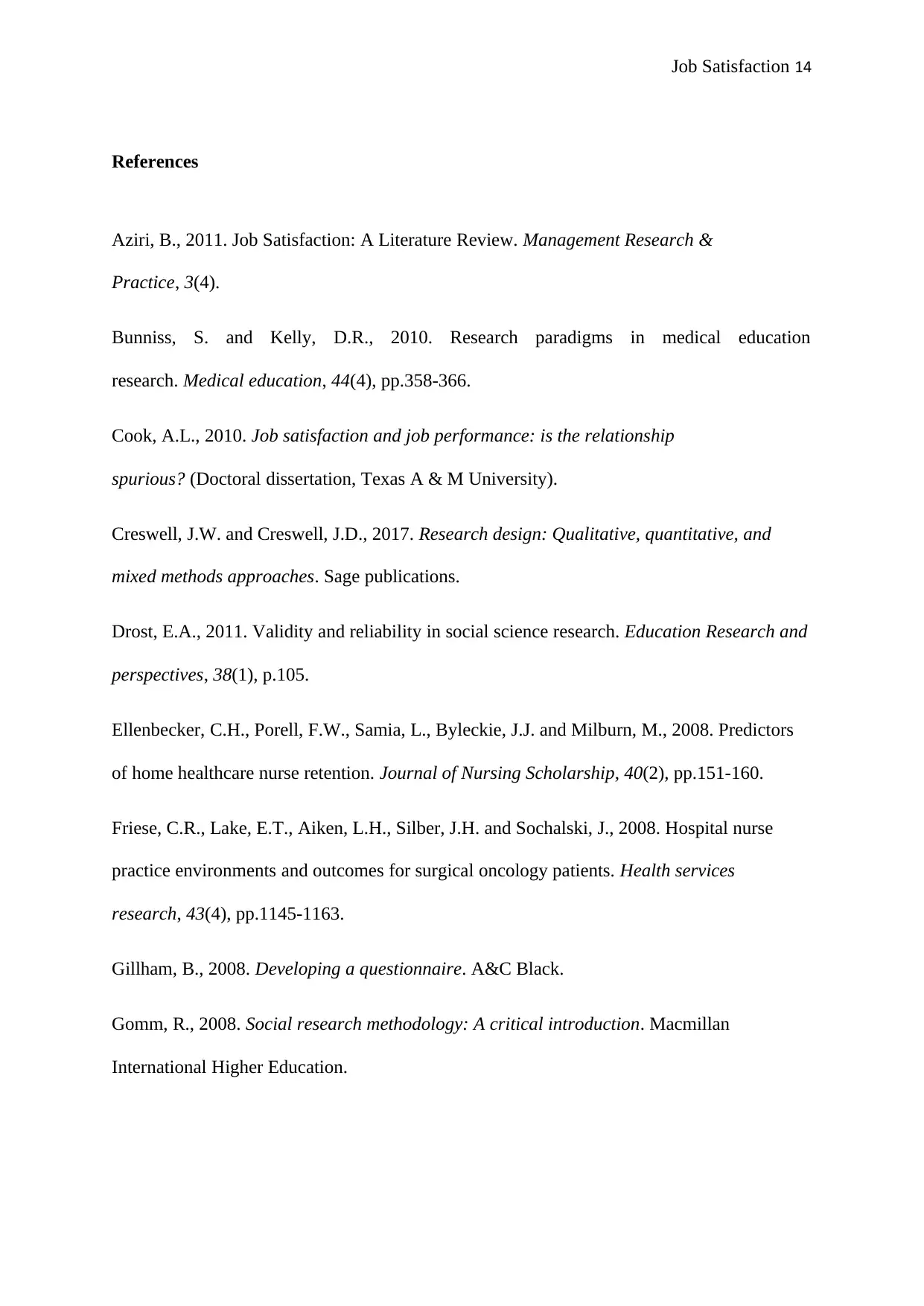
References
Aziri, B., 2011. Job Satisfaction: A Literature Review. Management Research &
Practice, 3(4).
Bunniss, S. and Kelly, D.R., 2010. Research paradigms in medical education
research. Medical education, 44(4), pp.358-366.
Cook, A.L., 2010. Job satisfaction and job performance: is the relationship
spurious? (Doctoral dissertation, Texas A & M University).
Creswell, J.W. and Creswell, J.D., 2017. Research design: Qualitative, quantitative, and
mixed methods approaches. Sage publications.
Drost, E.A., 2011. Validity and reliability in social science research. Education Research and
perspectives, 38(1), p.105.
Ellenbecker, C.H., Porell, F.W., Samia, L., Byleckie, J.J. and Milburn, M., 2008. Predictors
of home healthcare nurse retention. Journal of Nursing Scholarship, 40(2), pp.151-160.
Friese, C.R., Lake, E.T., Aiken, L.H., Silber, J.H. and Sochalski, J., 2008. Hospital nurse
practice environments and outcomes for surgical oncology patients. Health services
research, 43(4), pp.1145-1163.
Gillham, B., 2008. Developing a questionnaire. A&C Black.
Gomm, R., 2008. Social research methodology: A critical introduction. Macmillan
International Higher Education.
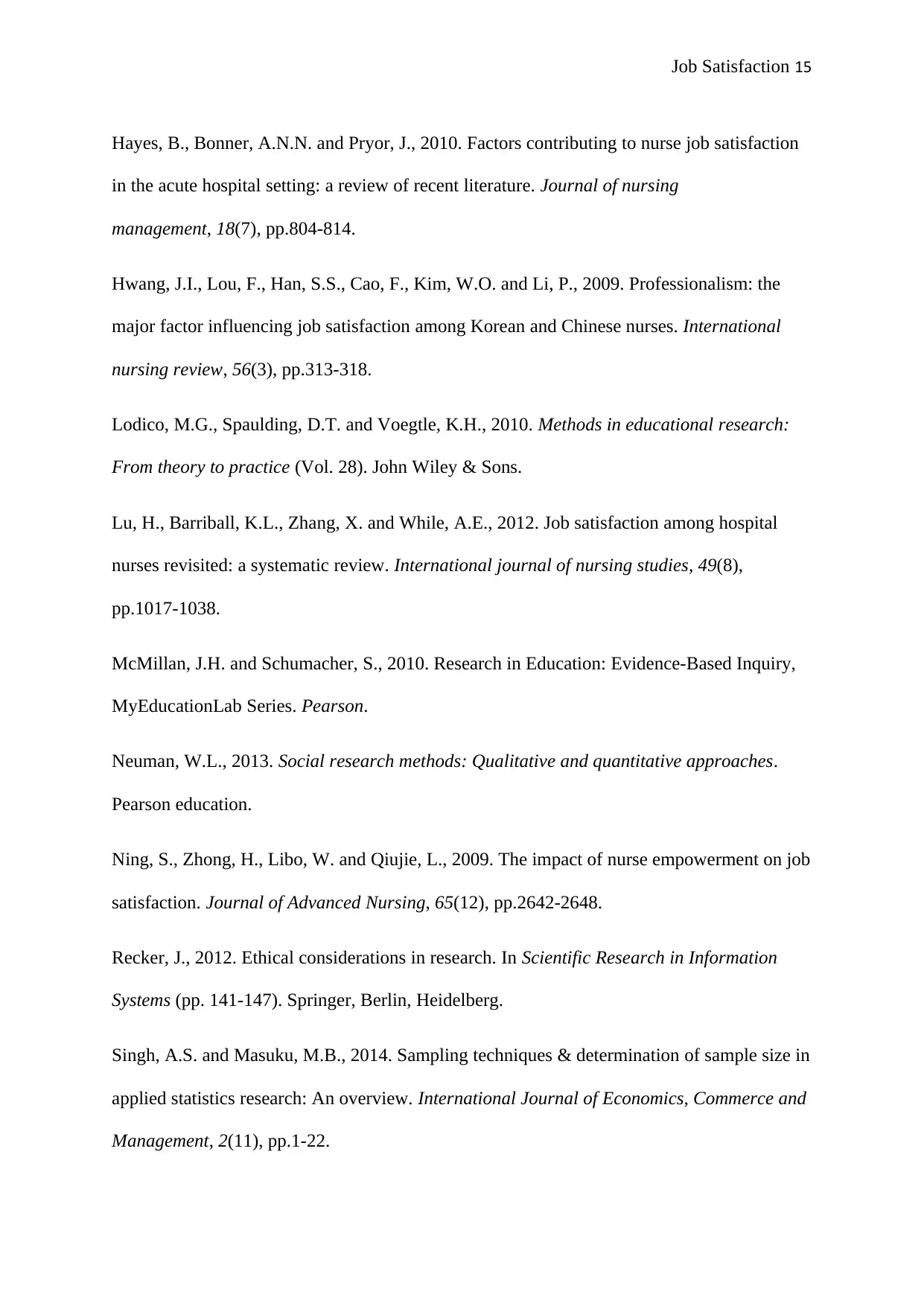
Hayes, B., Bonner, A.N.N. and Pryor, J., 2010. Factors contributing to nurse job satisfaction
in the acute hospital setting: a review of recent literature. Journal of nursing
management, 18(7), pp.804-814.
Hwang, J.I., Lou, F., Han, S.S., Cao, F., Kim, W.O. and Li, P., 2009. Professionalism: the
major factor influencing job satisfaction among Korean and Chinese nurses. International
nursing review, 56(3), pp.313-318.
Lodico, M.G., Spaulding, D.T. and Voegtle, K.H., 2010. Methods in educational research:
From theory to practice (Vol. 28). John Wiley & Sons.
Lu, H., Barriball, K.L., Zhang, X. and While, A.E., 2012. Job satisfaction among hospital
nurses revisited: a systematic review. International journal of nursing studies, 49(8),
pp.1017-1038.
McMillan, J.H. and Schumacher, S., 2010. Research in Education: Evidence-Based Inquiry,
MyEducationLab Series. Pearson.
Neuman, W.L., 2013. Social research methods: Qualitative and quantitative approaches.
Pearson education.
Ning, S., Zhong, H., Libo, W. and Qiujie, L., 2009. The impact of nurse empowerment on job
satisfaction. Journal of Advanced Nursing, 65(12), pp.2642-2648.
Recker, J., 2012. Ethical considerations in research. In Scientific Research in Information
Systems (pp. 141-147). Springer, Berlin, Heidelberg.
Singh, A.S. and Masuku, M.B., 2014. Sampling techniques & determination of sample size in
applied statistics research: An overview. International Journal of Economics, Commerce and
Management, 2(11), pp.1-22.
⊘ This is a preview!⊘
Do you want full access?
Subscribe today to unlock all pages.

Trusted by 1+ million students worldwide

Vijayalakshmi, P. and Kalidoss, K., 2015. Determinants of job satisfaction of bank
employees: A study with reference to public sector banks in mayiladuthurai
town. International Journal of Multidisciplinary Research and Development, 2(4), pp.175-
177.
Wang, L., Tao, H., Ellenbecker, C.H. and Liu, X., 2012. Job satisfaction, occupational
commitment and intent to stay among Chinese nurses: a cross‐sectional questionnaire
survey. Journal of advanced nursing, 68(3), pp.539-549.
Paraphrase This Document
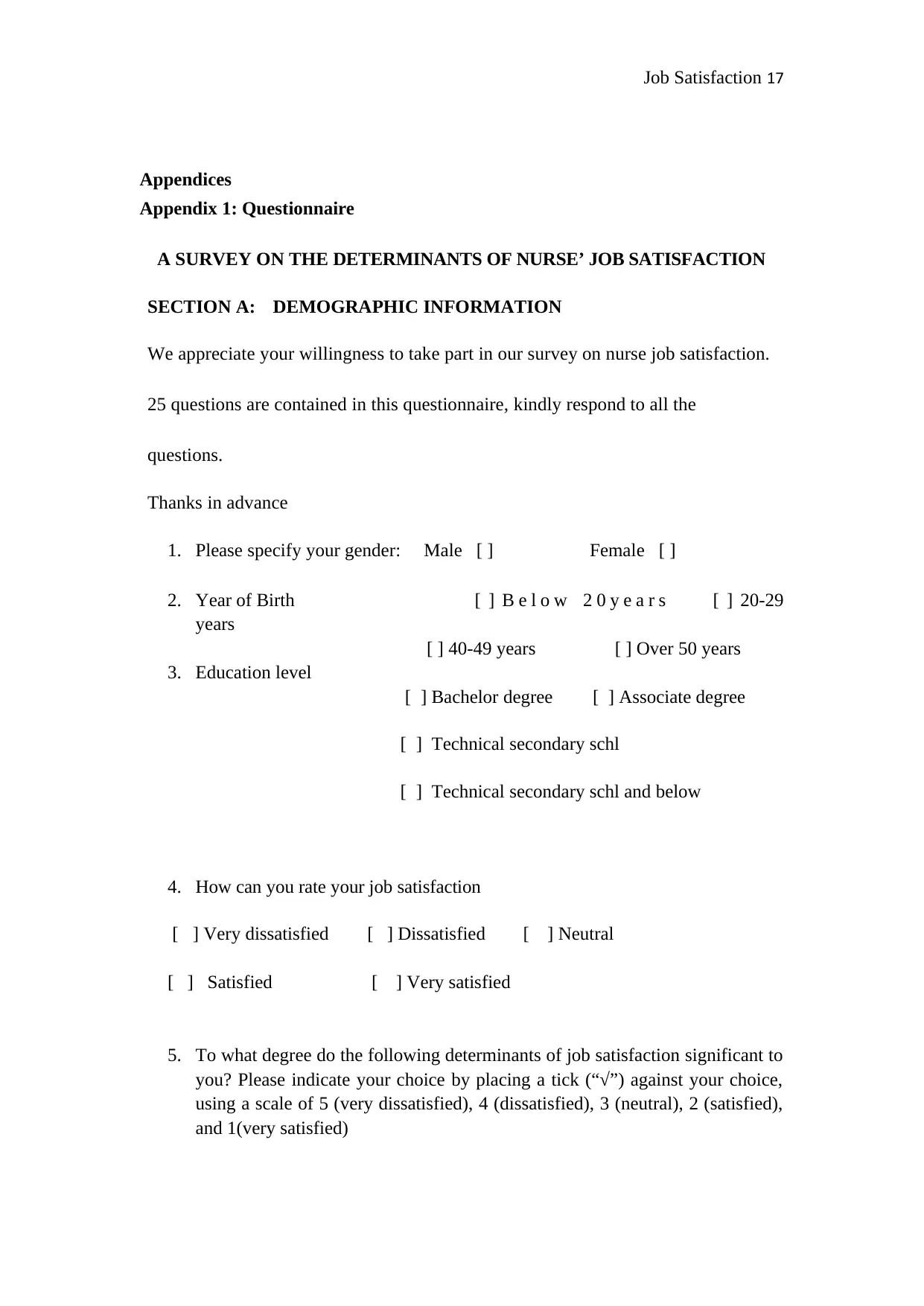
Appendices
Appendix 1: Questionnaire
A SURVEY ON THE DETERMINANTS OF NURSE’ JOB SATISFACTION
SECTION A: DEMOGRAPHIC INFORMATION
We appreciate your willingness to take part in our survey on nurse job satisfaction.
25 questions are contained in this questionnaire, kindly respond to all the
questions.
Thanks in advance
1. Please specify your gender: Male [ ] Female [ ]
2. Year of Birth [ ] B e l o w 2 0 y e a r s [ ] 20-29
years
[ ] 40-49 years [ ] Over 50 years
3. Education level
[ ] Bachelor degree [ ] Associate degree
[ ] Technical secondary schl
[ ] Technical secondary schl and below
4. How can you rate your job satisfaction
[ ] Very dissatisfied [ ] Dissatisfied [ ] Neutral
[ ] Satisfied [ ] Very satisfied
5. To what degree do the following determinants of job satisfaction significant to
you? Please indicate your choice by placing a tick (“√”) against your choice,
using a scale of 5 (very dissatisfied), 4 (dissatisfied), 3 (neutral), 2 (satisfied),
and 1(very satisfied)
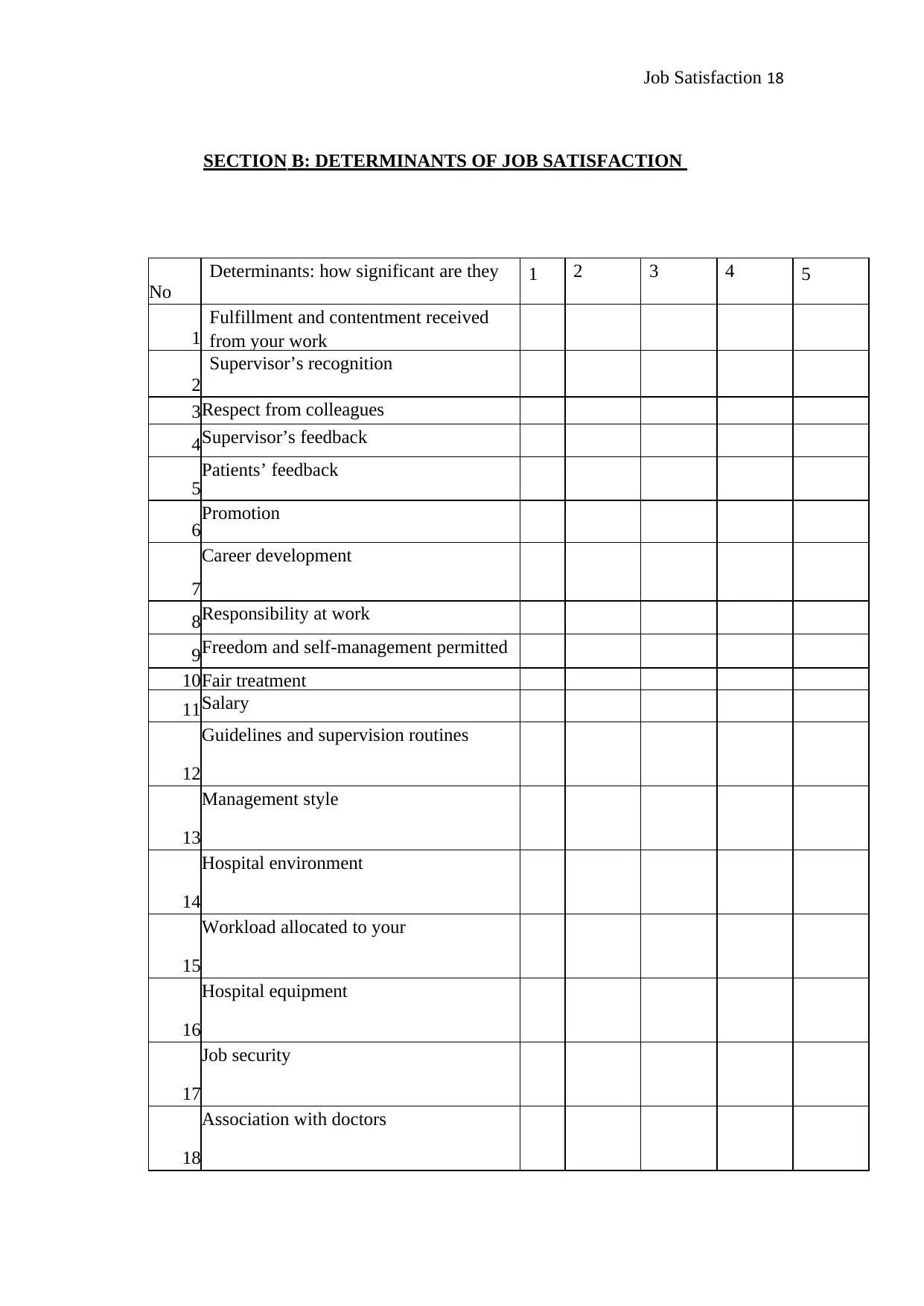
SECTION B: DETERMINANTS OF JOB SATISFACTION
No
Determinants: how significant are they 1 2 3 4 5
1
Fulfillment and contentment received
from your work
2
Supervisor’s recognition
3Respect from colleagues
4Supervisor’s feedback
5Patients’ feedback
6Promotion
7
Career development
8Responsibility at work
9Freedom and self-management permitted
10Fair treatment
11Salary
12
Guidelines and supervision routines
13
Management style
14
Hospital environment
15
Workload allocated to your
16
Hospital equipment
17
Job security
18
Association with doctors
⊘ This is a preview!⊘
Do you want full access?
Subscribe today to unlock all pages.

Trusted by 1+ million students worldwide
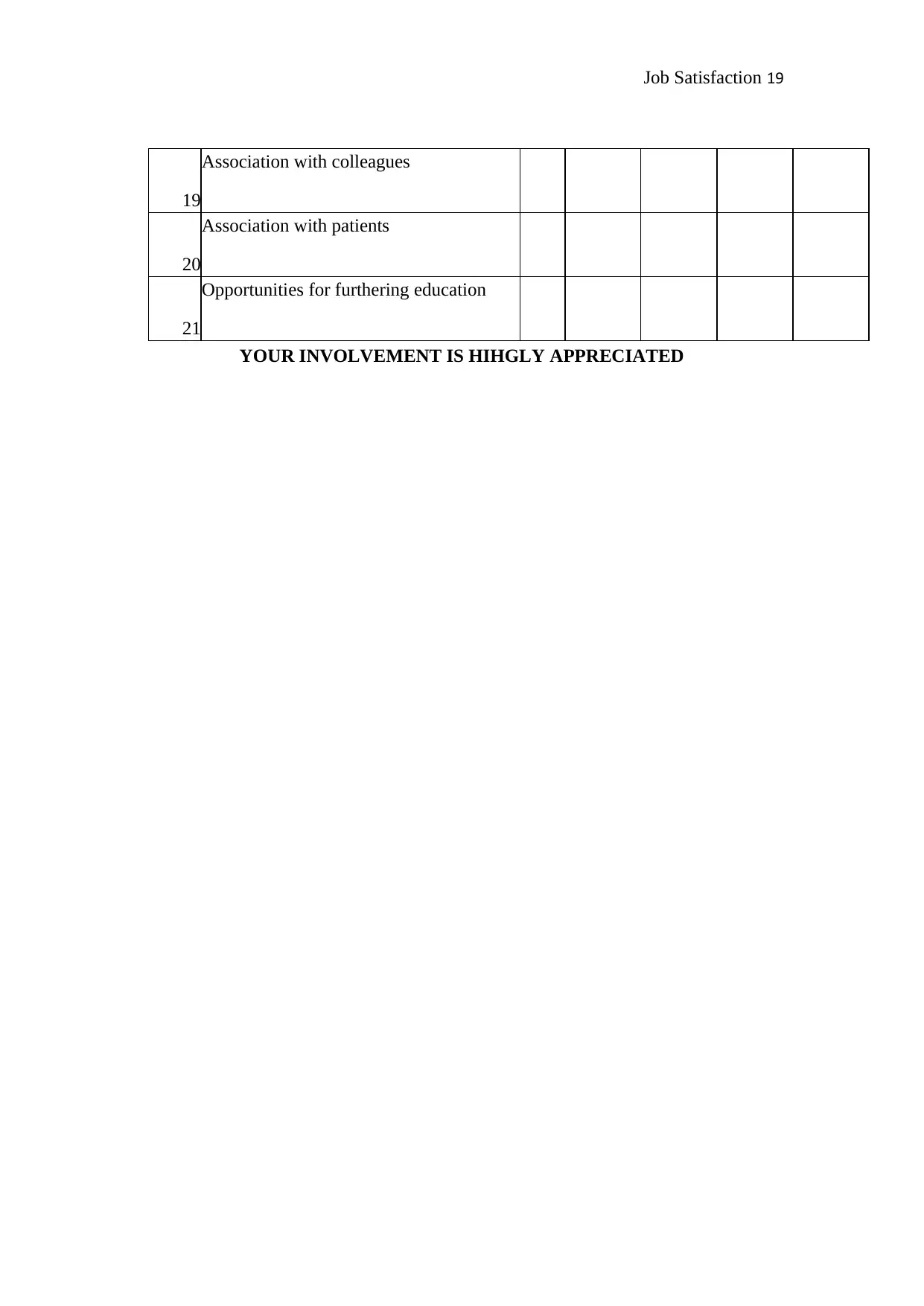
19
Association with colleagues
20
Association with patients
21
Opportunities for furthering education
YOUR INVOLVEMENT IS HIHGLY APPRECIATED
Related Documents
Your All-in-One AI-Powered Toolkit for Academic Success.
+13062052269
info@desklib.com
Available 24*7 on WhatsApp / Email
![[object Object]](/_next/static/media/star-bottom.7253800d.svg)
© 2024 | Zucol Services PVT LTD | All rights reserved.



